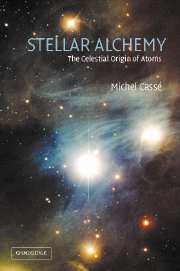Book contents
- Frontmatter
- Contents
- Preface
- Acknowledgements
- 1 Nuclear astrophysics: defence and illustration
- 2 Light from atoms, light from the sky
- 3 Visions
- 4 Contents of the sky: atomic sources and fountains
- 5 Nuclear suns
- 6 Sociology of stars and clouds
- 7 Histories
- 8 Ancient stars in the galactic halo
- 9 Conclusion
- Appendix 1 Invisible matter and energy
- Appendix 2 Supernovas and cosmology
- Appendix 3 Explosions
- Appendix 4 Stellar nucleosynthesis
- Appendix 5 Galactic evolution
- Appendix 6 Key dates
- Appendix 7 Constants and units
- Appendix 8 Websites
- Bibliography
- Index
8 - Ancient stars in the galactic halo
- Frontmatter
- Contents
- Preface
- Acknowledgements
- 1 Nuclear astrophysics: defence and illustration
- 2 Light from atoms, light from the sky
- 3 Visions
- 4 Contents of the sky: atomic sources and fountains
- 5 Nuclear suns
- 6 Sociology of stars and clouds
- 7 Histories
- 8 Ancient stars in the galactic halo
- 9 Conclusion
- Appendix 1 Invisible matter and energy
- Appendix 2 Supernovas and cosmology
- Appendix 3 Explosions
- Appendix 4 Stellar nucleosynthesis
- Appendix 5 Galactic evolution
- Appendix 6 Key dates
- Appendix 7 Constants and units
- Appendix 8 Websites
- Bibliography
- Index
Summary
Clues to the chemical evolution of the Galaxy
The evolution of the composition of matter can be traced back through the various ages of the Galaxy by systematically examining surface abundances over a vary large population of stars by means of spectroscopic analysis (Table 8.1). One is particularly interested in elements observed in the spectra of ancient suns in the galactic halo. These little stars, the oldest we know of, are still shining valiantly today, boasting their exceptional longevity (Fig. 8.1).
Let us now describe the method used. The most accessible elements are those possessing clear lines in the optical spectra of these fossilised objects. In contrast, certain elements like neon and argon are not determined in these stars, whether they be dwarfs or giants. In their normal state, the noble gases produce no optical emission.
Families that lend themselves best to this evolutionary analysis are:
the light nuclei Li, Be and B;
the α nuclei, i.e. multiples of the helium nucleus, such as Mg, Si, S and Ca;
nuclei around the iron peak, viz. Sc, Cr, Mn, Fe, Co, Ni, Cu and Zn;
heavy s and r isotopes like Sr, Y, Ba and Eu.
Among these, iron is relatively easy to measure and serves as a reference, as a metallicity index, and thus as an indicator of the degree of evolution. Indeed, it is common practice in astronomy to treat the terms iron content (Fe/H) and metallicity (Z) as synonymous.
- Type
- Chapter
- Information
- Stellar AlchemyThe Celestial Origin of Atoms, pp. 171 - 192Publisher: Cambridge University PressPrint publication year: 2003



